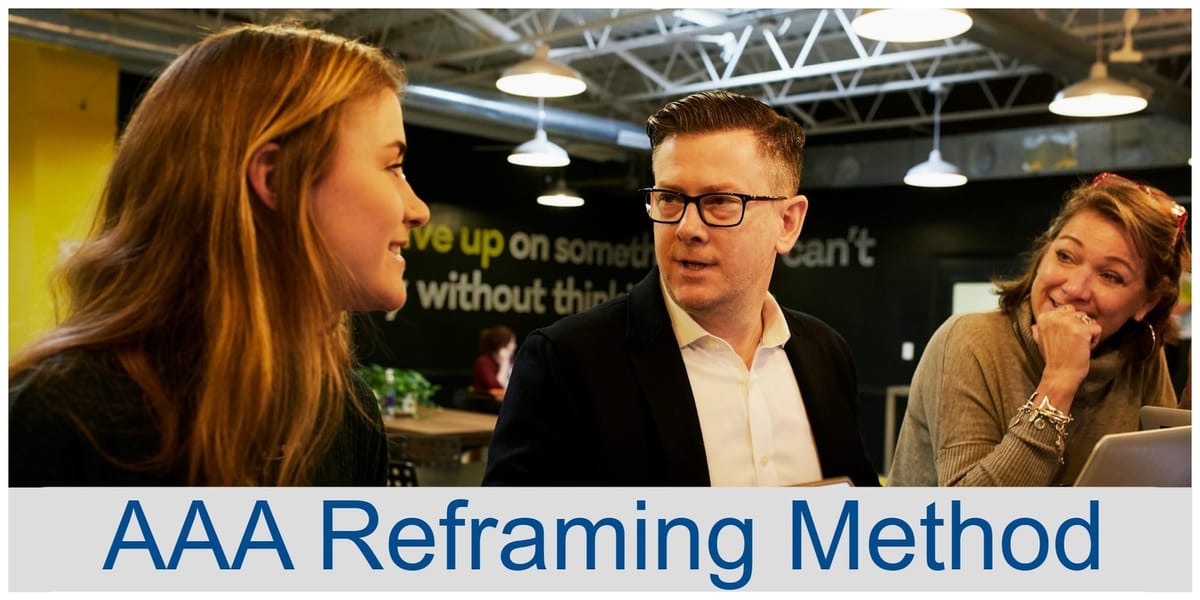The AAA Sales Framework: How to Reframe Questions and Handle Objections

Ever found yourself scrambling to answer a prospect’s tough question, only to feel the conversation slip away?
What if you could turn those moments into opportunities — guiding the sale forward while building trust and rapport?
That’s where the AAA Sales Framework comes in. This simple, reframing technique helps you handle objections, steer conversations with confidence, and position yourself as a trusted advisor — all without sounding pushy.
In this guide, you’ll learn how to reframe questions in sales using the AAA method, why it works, and how top performers use it to close deals.
Why Reframing Questions in Sales Builds Trust and Control
In sales, the person asking the questions controls the conversation.
When a prospect throws a curveball like: Why is your pricing higher than competitors?
…a direct answer may put you on the defensive.
Reframing flips the script. Instead of reacting, you respond with a question that reshapes the dialogue and guides the prospect back toward their goals.
Think of it like steering a ship: you adjust the sails (the conversation) toward your destination (the close) instead of drifting wherever the wind blows.
The AAA Framework: Acknowledge, Associate, Ask
The AAA method is a three-step process that keeps sales conversations productive, collaborative, and consultative.
Here’s how to apply it:
- Acknowledge
Show you’re listening and validate their concern.
Restate their question to build rapport.
Example:
Prospect: Does your software integrate with our current tools?
You: Integration is critical - I’m glad you brought that up. - Associate
Link their concern to a positive trait or successful outcome.
Use examples from other clients.
Example:
That’s something our clients in [Industry X] prioritized too. Once they saw how seamless integration boosted their productivity, they were all in. - Ask
Redirect with a strategic question that advances the sale.
Keep the conversation focused on solutions.
Example:
To tailor this to your workflow, could we schedule a demo with your IT team next week?
This approach transforms objections into stepping stones, positioning you as a consultant rather than a pitch machine.
5 Rules for Ethical Reframing in Sales
Reframing isn’t about manipulation - it’s about clarity and alignment. Keep these rules in mind:
- Don’t Invite Unnecessary Objections
Avoid vague questions like, Any concerns? Instead, highlight relevant benefits proactively. - Skip the Debate
If a prospect says, Your product lacks Feature X, don’t argue. Instead ask, Feature X is helpful - how do you see it impacting your goals? - Let Them Sell Themselves
Prompt prospect to explain their own fit: What would solving [Problem Y] mean for your team? - Use Straw Men Tactfully
Introduce gentle hypotheticals: Some clients worry about rollout speed. How important is fast implementation for you? - Stay Curious
Ask why often to uncover motivations and build genuine rapport.
Frequently Asked Questions (FAQ)
Q: What is the AAA Sales Framework?
A: The AAA method stands for Acknowledge, Associate, Ask. It’s a reframing technique that helps sales professionals handle objections and guide conversations with confidence.
Q: How does reframing questions help in sales?
A: Reframing prevents defensive answers, builds trust, and keeps the prospect focused on their goals rather than your limitations.
Q: Can I use the AAA method for price objections?
A: Yes. Instead of justifying price, acknowledge their concern, associate it with value others gained, and ask a question that shifts focus to ROI or outcomes.
Q: Is reframing manipulative?
A: No — ethical reframing is about clarity and alignment, not trickery. It ensures the conversation serves the prospect’s real needs.
Reframe to Close, Not to Coax
The AAA Framework isn’t just a sales tactic — it’s a mindset shift.
By acknowledging concerns, associating them with success, and asking purposeful questions, you empower prospects to see their own path forward.
Next time a prospect asks a tricky question, pause — then Acknowledge, Associate, and Ask. You’ll notice how quickly the conversation transforms.
Keep Crushing!
- Sales Guy
P.S. If you don’t know the answer, don’t panic. Ask a thoughtful question about their question — it keeps the conversation moving.

